

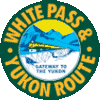
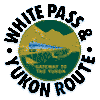






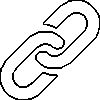

White Pass & Yukon Route
231 Second Avenue
Skagway Alaska USA
N59.453123 W135.318266 (Skagway Depot)
(Skagway Depot)
Growing up in Vancouver, British Columbia, during the 1950's and 1960's my first introduction to the White Pass & Yukon Route was a small forest green coloured cube which looked to be about 8 feet square sitting on a North Vancouver dock. Lettering on it's side read "White Pass". This container was developed by the railway company for trans-shipment by road, rail, and the world's first containerized ship, the Clifford J. Rogers. This tiny box began the massive explosion in intermodal container traffic. Such a simple idea, and it started right here on the White Pass & Yukon Route.
which looked to be about 8 feet square sitting on a North Vancouver dock. Lettering on it's side read "White Pass". This container was developed by the railway company for trans-shipment by road, rail, and the world's first containerized ship, the Clifford J. Rogers. This tiny box began the massive explosion in intermodal container traffic. Such a simple idea, and it started right here on the White Pass & Yukon Route.
On 17 Aug 1896 George Carmack and two Indian companions, Skookum Jim and Dawson Charlie, discovered gold on Bonanza Creek in the Klondike Valley of the Yukon. The few flakes they uncovered from the creek bottom hardly filled a spent rifle cartridge but it was enough to trigger the Klondike Gold Rush which became one of the most lively and colourful events in history.
The mad stampede which followed created such a furor throughout North America and the rest of the world that the names "Klondike" and "Yukon" became synonymous with untold riches. Stampeders left from American and Canadian ports such as Seattle and Victoria , while some even tried the trek overland from Edmonton, Alberta, in a mad rush caused by "gold fever".
, while some even tried the trek overland from Edmonton, Alberta, in a mad rush caused by "gold fever".
Most Stampeders (Klondikers, prospectors, sourdoughs) landed at Skagway, Alaska, and transferred their outfits from the ships to their backs and started the forty-mile trek over Chilkoot or White Pass
(Klondikers, prospectors, sourdoughs) landed at Skagway, Alaska, and transferred their outfits from the ships to their backs and started the forty-mile trek over Chilkoot or White Pass . The White Pass trail
. The White Pass trail conditions were terrible. The route was narrow, steep, slick, and overcrowded. Nearly 3,000 pack animals died. Stampeders rushing over the pass during the summer of 1897 had little concern for their animals. Exhausted horses starved, were injured on rough ground, became mired in mud, or fell off cliffs. The White Pass route was renamed the Dead Horse Trail
conditions were terrible. The route was narrow, steep, slick, and overcrowded. Nearly 3,000 pack animals died. Stampeders rushing over the pass during the summer of 1897 had little concern for their animals. Exhausted horses starved, were injured on rough ground, became mired in mud, or fell off cliffs. The White Pass route was renamed the Dead Horse Trail with one particular area known as Dead Horse Gulch.
with one particular area known as Dead Horse Gulch.
Upon reaching Lake Bennett, British Columbia, Stampeders settled in and built boats and rafts
settled in and built boats and rafts from hand-hewn timber to carry themselves and their outfits along Lake Bennett, Marsh Lake, and the Yukon River to placer mines such as those found along Bonanza Creek
from hand-hewn timber to carry themselves and their outfits along Lake Bennett, Marsh Lake, and the Yukon River to placer mines such as those found along Bonanza Creek in the Klondike Gold Fields.
in the Klondike Gold Fields.
It was evident from the start that the requirements of the Klondike Gold Fields and its populace could not be met without a permanent and properly organized transportation system.
Canadian railway contractor Michael J. Heney , known as "The Irish Prince", had just returned to Skagway after making an independent examination of the White Pass and was convinced that a railway could be constructed through the rugged St. Elias Mountain Range which separates Yukon from the sea. He was equally convinced that he was the one who could do it. By chance, "Big Mike", as he was also known, and Sir Thomas Tancrede, representing an English group willing to finance a railway, met at Skagway. They talked far into the night and by early morning the construction of the railway through the toughest country in North America was no longer a dream, but an accepted challenge that would demand everything Heney had to offer, and more besides.
, known as "The Irish Prince", had just returned to Skagway after making an independent examination of the White Pass and was convinced that a railway could be constructed through the rugged St. Elias Mountain Range which separates Yukon from the sea. He was equally convinced that he was the one who could do it. By chance, "Big Mike", as he was also known, and Sir Thomas Tancrede, representing an English group willing to finance a railway, met at Skagway. They talked far into the night and by early morning the construction of the railway through the toughest country in North America was no longer a dream, but an accepted challenge that would demand everything Heney had to offer, and more besides.
The White Pass & Yukon Route was organized in the spring of 1898 and construction began with the arrival of material at Skagway on 27 May 1898. Almost immediately the ribbons of steel pointed north towards the White Pass. By July 1898 a passenger train
with the arrival of material at Skagway on 27 May 1898. Almost immediately the ribbons of steel pointed north towards the White Pass. By July 1898 a passenger train was placed in service and it operated a distance of four miles. This was the first train to run in Alaska and the farthest north any railway ever operated in North America at that time.
was placed in service and it operated a distance of four miles. This was the first train to run in Alaska and the farthest north any railway ever operated in North America at that time.
By 18 Feb 1899, the track reached the summit of White Pass and by 6 Jul 1899 construction reached the head of Lake Bennett
of White Pass and by 6 Jul 1899 construction reached the head of Lake Bennett in B.C. While gangs blasted and hacked their way north through the pass, construction started from Whitehorse, Yukon, working south towards Carcross. The two construction groups met at Carcross on 29 Jul 1900 where the last spike ceremony was attended by S.H. Graves, the company's first President, and a colourful group of Canadian and American civil and military dignitaries.
in B.C. While gangs blasted and hacked their way north through the pass, construction started from Whitehorse, Yukon, working south towards Carcross. The two construction groups met at Carcross on 29 Jul 1900 where the last spike ceremony was attended by S.H. Graves, the company's first President, and a colourful group of Canadian and American civil and military dignitaries.
Started by an experienced trackman, the "last spike" stood upright and gleaming beside the rail. Mr. Graves, being a good host, invited the senior American Army officer to strike the first blow. After a series of disastrous attempts, the spike, while bent, was clearly the winner. Others took up the challenge, cheered on by the celebrating crowd, but the spike, which by now had the general characteristics of a piece of boiled spaghetti, successfully stood its ground. While leaving the scene, Mr. Graves caught the eye of the track superintendent who unobtrusively replaced the historic spike with a more practical one and unceremoniously drove it home.
The construction of the railway was one of the most difficult ever engineered. It was a thousand miles from the closest base of supplies and communications between Skagway and cities father south were confined to mail carried by coastal steamships, which operated an irregular service. There was no heavy construction equipment. With nothing but horses, shovels, black powder, and men, the right-of-way was hacked through barriers of solid rock. Vast quantities of powder were used and in one case a cliff
and communications between Skagway and cities father south were confined to mail carried by coastal steamships, which operated an irregular service. There was no heavy construction equipment. With nothing but horses, shovels, black powder, and men, the right-of-way was hacked through barriers of solid rock. Vast quantities of powder were used and in one case a cliff 120 feet (36.6 metres) in height, 70 feet (21.3 metres) in depth, and 20 feet (6.1 metres) in thickness was blasted away.
120 feet (36.6 metres) in height, 70 feet (21.3 metres) in depth, and 20 feet (6.1 metres) in thickness was blasted away.
Probably no tunnel in the world was built under greater difficulties than this one which penetrated a perpendicular barrier of rock jutting out of the mountainside like a giant flying buttress. It required the construction of a huge wooden trestle
in the world was built under greater difficulties than this one which penetrated a perpendicular barrier of rock jutting out of the mountainside like a giant flying buttress. It required the construction of a huge wooden trestle to reach the tunnel's southern portal. Machinery and equipment to construct this 250 foot (76.2 metres) tunnel were manhandled up the sides of cliffs.
to reach the tunnel's southern portal. Machinery and equipment to construct this 250 foot (76.2 metres) tunnel were manhandled up the sides of cliffs.
A short distance from the summit of the pass, a deep canyon is spanned by a steel cantilever bridge, 215 feet (65.5 metres) from the creek's bed. Below, in Dead Horse Gulch, winds the old White Pass Trail, worn into the native rock by thousands of Stampeders who formed the long black line of humanity now associated with the Klondike Gold Rush and the Trail of '98. A high level cantilever bridge paralleling the gulch was built in 1900. To improve the grade and curvature of the railroad, this bridge was replaced in 1969 by a new bridge and construction of the line's second tunnel.
From sea level at Skagway, this narrow gauge (3 foot or 91.4 centimeters) railroad climbs to the summit of White Pass, 2,885 feet (879 metres), in only 21 miles (34 kilometers). The average grade to the summit is 2.6 percent with the steepest grade about 4 percent. The highest point on the line is Log Cabin, B.C., at milepost 33, which has an altitude of 2,916 feet (889 metres). The line from Skagway to Whitehorse is 111 miles (178 kilometers). Of this, 20 miles (33 kilometers) are in Alaska, 32 miles (52 kilometers) are in B.C., and 58 miles (94 kilometers) are within the Yukon Territory.
The railway was placed in regular service by August, 1900, although segments of the incomplete line augmented by horse-drawn wagons had provided regular service into Whitehorse since early 1899 - 1974 White Pass & Yukon Route - slightly revised
Jefferson Randolph "Soapy" Smith was born in Georgia in 1860. As a young man he drifted west, lured to dance halls and gambling dens, where he became an expert at manipulating the three walnut shells and the pea con-game. For 20 years he perfected his con-man's trade in various Colorado towns until joining the Klondike Gold Rush.
In Skagway he was a skilled and intelligent criminal where he controlled a well-organized underworld of thieves, thugs, and con-men during the height of the gold rush, a thousand miles away from law and order. They got rich preying on gullible miners during 1897 and 1898. He ran crooked gambling halls, freight companies that hauled nothing, telegraph offices that had no telegraph link, even an "army enlistment" tent where the victim's clothes and possessions were stolen while a "doctor" gave him a physical examination. His men met Stampeders at the docks posing as clergymen, newspaper reporters, knowledgeable old-timers, and freight company representatives. After sizing up a prospect with a fat wallet, they would direct him to one of Soapy's bogus businesses or mark him for later robbery.
One stubborn miner, instead of slinking away beaten, fired up the citizens of Skagway who formed a vigilante committee headed by Frank Reid, a civil engineer. Reid stood up to Soapy and in the ensuing gunfight on the Juneau Company Wharf shot Soapy in the heart killing him. Reid, who also died from his wounds, was buried a hero with a more impressive tombstone to prove it.
in the heart killing him. Reid, who also died from his wounds, was buried a hero with a more impressive tombstone to prove it.
The railway transported many hopeful Stampeders north in their rush to find a bonanza. On balance, most probably returned poorer but wiser men after selling their outfits to obtain passage home.
their outfits to obtain passage home.
Anton and Violet Stander were just a couple living together in Dawson during 1897 when the Klondike Gold Rush hit. They agreed to share any riches they might find. Anton then wandered up Bonanza Creek and found a third of an ounce of gold in the very first pan on his claim. It isn't known how much they later mined, but as things turned out nearly every claim along Bonanza Creek produced, at minimum, a half a million dollars each. At today's prices this would equal more than ten and a half million dollars.
Taking their riches with them the couple left Dawson City to be married at San Francisco in 1901 before settling in Seattle, Washington. They invested their riches in land and property. In 1905 they opened the newly constructed Stander Hotel claiming it was the finest family hotel in the Northwest with 250 rooms, private baths, telephones, and modern ventilation.
Before a year was up a Deputy Sheriff entered the hotel and approached Stander. In a panic Stander raced out a door and down an alley chased by the Sheriff who fired a warning shot at Stander's feet. Stander immediately stopped whereupon the Sheriff served him with a writ. It was an order forbidding sale of any property until his wife's divorce suit was settled.
In the ensuing settlement the two divided property estimated at US$900,000 but they were so heavily mortgaged and in debt few assets remained to them. Even with all their new found wealth it seems they ended no better-off than the average stampeder who returned penniless.

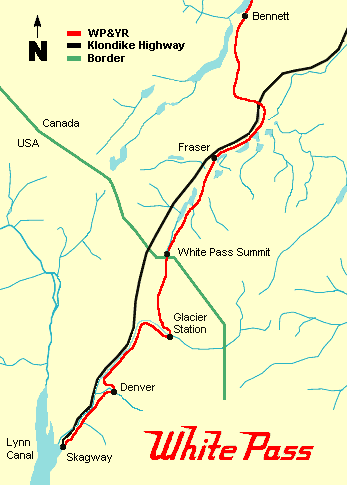
Sunday, 07:30 hours, 22 Aug 2004, and the boys are still boozing in the Red Onion Saloon and Bordello. (Well, technically, the upstairs bordello is now a museum.) A few blocks north on Broadway street lies another historic saloon, The Mascot , now run by the government. The sign inside reads "No smoking, eating, or drinking". Only the government would run a bar where you can't smoke, eat, or drink!
, now run by the government. The sign inside reads "No smoking, eating, or drinking". Only the government would run a bar where you can't smoke, eat, or drink!
By noon Skagway is packed with "New Stampeders", cruise ship tourists. If you sit across from the Red Onion on the boardwalk you'll hear 4 different languages spoken and watch 4 tour busses drive by every 4 minutes. The street and parking lots are filled with New Stampeders and touring company vehicles. New Stampeders snap photos from the middle of Broadway while dodging the bright yellow Skagway Streetcar, actually a replica old-time bus. Souvenir and jewelry shops occupy the historic and replicated buildings both sides of Broadway. There's a line-up waiting to buy lunch at the Sweet Tooth Cafe. The virtues of Soapy Smith are alive and well as some merchants fleece the suckers by selling small bottles of Coca-Cola at US$2.08 (C$2.76) each. Hawkers occupy doorways flogging various tours and a Soapy Smith stage show. It all resembles Disneyland, only slightly less sanitized.
Walk ten blocks north on Broadway and there's not a New Stampeder in sight. Surprisingly, large numbers of spawning salmon splash in a narrow ditch all along the east side of the street.
Four WP&YR trains depart Skagway on this particular day. A "White Pass Excursion" and a "Fraser Turn" both leave early in the morning. On the Fraser Turn passengers ride to Fraser, British Columbia. A loaded bus, or busses, from Whitehorse, Yukon, meet the train at Fraser and passengers are exchanged with those arriving on the Fraser Turn.

The Summit Excursion travels from Skagway to the summit of White Pass and returns. Passengers are not permitted to leave the train as there is no customs and immigration service where the railroad crosses the international border at White Pass Summit.
Both these trains run again during the afternoon.
Boarding a train at Skagway can be confusing. Summit Excursion trains receive and discharge at the Skagway depot but also from cruise ships directly on the appropriate jetty. Passengers arriving in Skagway via cruise ship purchase tickets on their ship. Boarding the train on their jetty they are returned to the same point at the end of the Summit Excursion.
but also from cruise ships directly on the appropriate jetty. Passengers arriving in Skagway via cruise ship purchase tickets on their ship. Boarding the train on their jetty they are returned to the same point at the end of the Summit Excursion.
Other passengers buy tickets at the depot (reservations are required) then board and disembark there. So, for each Summit Excursion, a train stops twice in Skagway. Skagway Junction, immediately east of the depot, is where trains switch between dock and depot.
The Summit Excursion does not have assigned seating, it's first come, first served, when boarding. What reservation agents don't mention though, is that cruise ship passengers are loaded first. This leaves only 3 or 4 cars at the front of the train for those boarding at the depot. It seems cruise ship passengers get boarding priority, after all, that's where the railroad's income lies today, new ship borne Stampeders.
does not have assigned seating, it's first come, first served, when boarding. What reservation agents don't mention though, is that cruise ship passengers are loaded first. This leaves only 3 or 4 cars at the front of the train for those boarding at the depot. It seems cruise ship passengers get boarding priority, after all, that's where the railroad's income lies today, new ship borne Stampeders.

For the best view of the Skagway River canyon departing Skagway, when facing the front of the train, sit on the left side. Upon reaching White Pass summit the coach walkover seats are reversed so everyone faces the opposite direction. Out of courtesy to those who chose the wrong side before departure, those on the canyon side will be requested to swap seats with those across the aisle during the return trip. Passengers are permitted to ride on the open platforms which become crowded when photo opportunities arise. An open-air coach would be well patronized if it were provided.
On this particular day, four cars from an arriving train were to be dropped at the depot. A jammed coupler delayed the afternoon Summit Excursion departure. Depot passengers were requested to walk to Skagway Junction where they boarded the train, already nearly full with cruise ship passengers, coming from the Railway Dock. Headed by three DL535E diesel units for assault of the steep grade one empty car is deliberately placed directly behind the units to give relief from diesel exhaust. DL535Es have Alco engines, no more need be said?
The City of Skagway lies on the narrow strip of the Skagway River's flat delta. Mostly pine trees cover the coastal mountains which climb steeply on either side of the town fencing it in. The only route north is the steep climb up the valley alongside the Skagway River to the summit at White Pass. Trains begin this climb at a point just past the railway's shops near the cemetery where Soapy Smith lies buried.
7.3 miles after leaving Skagway the train reaches 640 feet (195 metres) of elevation as it climbs above the old Brackett Road . Built by George A. Brackett in 1897 he extracted a hefty toll for freight, horses, and wagons using his road to reach White Pass City. The roads existence slowed construction of the railway as each dynamite blast would cover the road with debris which had to be removed by the railway labourers. Eventually the railroad bought out the owner for US$100,000 thereby eliminating this problem plus the possibility of any future business competition. The roof of the American customs and immigration building located on the Klondike Highway is clearly visible on the left side of the photo.
. Built by George A. Brackett in 1897 he extracted a hefty toll for freight, horses, and wagons using his road to reach White Pass City. The roads existence slowed construction of the railway as each dynamite blast would cover the road with debris which had to be removed by the railway labourers. Eventually the railroad bought out the owner for US$100,000 thereby eliminating this problem plus the possibility of any future business competition. The roof of the American customs and immigration building located on the Klondike Highway is clearly visible on the left side of the photo.
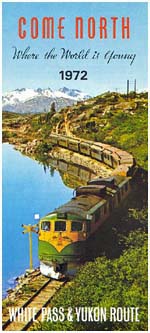
When first constructed the railroad had only one tunnel located at milepost 16.0 which was reached from the south by bridging a ravine with a wooden trestle . The three DL535Es assigned to this train pull easily into tunnel mountain as they cross the railroad's last remaining wooden trestle. The elevation here is now at 2,275 feet (693 metres) above Skagway.
. The three DL535Es assigned to this train pull easily into tunnel mountain as they cross the railroad's last remaining wooden trestle. The elevation here is now at 2,275 feet (693 metres) above Skagway.
Shortly after emerging from Tunnel Mountain look back along the route southwards to see the Lynn Canal with the Chilkat Range forming a snow covered backdrop. Look closely in the "V" formed by the mountains and you can just distinguish the line of railway that leads east up the Skagway River fork to Glacier Station far below in the trees. This photo location is known as Inspiration Point .
.
A little less than two miles farther up the hill lies the abandoned cantilever steel bridge at milepost 18.6 which spans a tributary to Dead Horse Gulch where as many as 3,000 horses died of neglect by Stampeders. This old abandoned bridge, constructed in 1901, was the tallest cantilever bridge in the world at that time. In 1969 a new girder bridge
at milepost 18.6 which spans a tributary to Dead Horse Gulch where as many as 3,000 horses died of neglect by Stampeders. This old abandoned bridge, constructed in 1901, was the tallest cantilever bridge in the world at that time. In 1969 a new girder bridge constructed further to the east across the gulch replaced the cantilever bridge. This necessitated drilling a second 675 foot (206 metres) long tunnel to connect with the original grade.
constructed further to the east across the gulch replaced the cantilever bridge. This necessitated drilling a second 675 foot (206 metres) long tunnel to connect with the original grade.
Two miles past this point the canyon narrows as the international border at White Pass summit is reached. A run-around siding is located here permits the locomotives to uncouple and back around the passenger cars to the opposite end. They are then re-coupled to head back down the hill on the return journey to Skagway. This siding straddles the international border. Since part or all of the train is now in Canada, passengers are not permitted to leave the train. Canadian customs agents and facilities are located at Fraser, B.C., seven miles to the north.
the passenger cars to the opposite end. They are then re-coupled to head back down the hill on the return journey to Skagway. This siding straddles the international border. Since part or all of the train is now in Canada, passengers are not permitted to leave the train. Canadian customs agents and facilities are located at Fraser, B.C., seven miles to the north.
We have now reached the end of our Summit Excursion at an elevation of 2,865 feet (873 metres) above sea level. This also concludes the end of this narrative but you will find additional information plus steam engine photos included in the section named "North of the Summit" below.
0.0 - Skagway, known as the gateway to the Yukon ever since the Klondike Gold Rush of 1897-1898. Once a city of 15,000 Stampeders, it is now a quiet town of 900 residents and the headquarters of the White Pass & Yukon Route;
1.9 - WY&YR shops are located on the flat delta of the Skagway River at the north end of the city;
2.5 - Gold Rush Cemetery is the burial place of the infamous "Soapy" Smith;
5.8 - Denver is located at the crossing of the Skagway River's east fork;
6.9 - Rocky Point offers a great view of Skagway from the train;
7.3 - Brackett Road is the start of the old wagon toll road over the White Pass;
8.5 - Clifton was blasted out of solid granite where a large chunk still overhangs the track;
10.4 - Black Cross Rock where a blasting accident in 1898 killed two railway construction workers beneath a 100 ton granite rock;
12.3 - Heney Station named after Michael J. Heney marks the spot of a tramway once used to transfer freight to pack horses;
14.0 - Glacier Station, here the railway crosses a tributary river, once a site where steam locomotive water was replenished during ascent of the pass;
16.0 - Tunnel Mountain is pierced by 250 foot (76.2 metres) tunnel 1 and reached from the south by a trestle spanning Glacier Gorge;
17.0 - Inspiration Point offers a great view of Lynn Canal to the south;
17.5 - Dead Horse Gulch where nearly 3,000 pack animals died of mishap or neglect by the Stampeders;
18.6 - Steel Bridge constructed in 1901 was the tallest cantilevered bridge in the world for a time but was abandoned in 1969 when replaced by the current bridge spanning the gorge immediately to the east;
18.8 - Tunnel Two is 675 feet (205.7 metres) long and was drilled in 1969 to connect with the current bridge by this point;
19.3 - Trail of '98 is visible after passing the north portal of Tunnel Two;
20.4 - White Pass Summit is located at an elevation of 2,865 feet (873 metres) at the international border;
27.7 - Fraser has a run-around siding near the Canadian customs house.
While WP&YR tracks continue all the way to Whitehorse they are currently functional only as far as Carcross. Between there and Whitehorse trees have overtaken the right-of-way. Tie replacement is in progress at the coach yard in Skagway. Various stretches along the route have fresh clean ballast applied. Clearing of brush along the right-of-way and evidence of bulldozer grading is visible where the Klondike Highway crosses the railroad. A work train of side-dump cars containing waste worked this area on 21 Aug 2004. The trackage at Carcross over the bridge looks to be in good shape. I don't know what the railroad's future plans may be but they are certainly maintaining the property. It has improved significantly since my visit many years ago.
Once a week, on Saturdays, between 4 Jun 2004 and 28 Aug 2004 Baldwin steam locomotive Number 73 made a passenger run between Skagway and Lake Bennett, B.C., named the Bennett Excursion, of course.
The following 7 photos show parts of that 21 Aug 2004 run.
You may have noticed in the photo of DL535E number 109 running around the passenger cars at White Pass summit there is little vegetation at there. Progressing north from this point small evergreen trees begin to take hold. The rocky land is dotted with pretty little emerald coloured lakes. Glaciers are visible on the distant mountains. Approaching Fraser the trees reach a height of 6 to 8 feet. North of here they continue to grow in height and diameter. WP&YR 73 North is shown here passing the balloon track located just south of Fraser. The flat car behind the engine carries hikers back-packs and luggage.
is shown here passing the balloon track located just south of Fraser. The flat car behind the engine carries hikers back-packs and luggage.
Number 73 stops at Fraser to take on water. The square water tower is not functional. Water is obtained from the lake on the left of the photo. Number 73, just off the siding, departs on the main track towards Bennett. The tail-end of the Fraser Turn can be seen leaving for Skagway after transferring passengers to busses from Whitehorse. Canada customs is directly behind the vehicles in the gravel parking lot.
on the main track towards Bennett. The tail-end of the Fraser Turn can be seen leaving for Skagway after transferring passengers to busses from Whitehorse. Canada customs is directly behind the vehicles in the gravel parking lot.
Heavy overcast sky dulls the light as 73 continues on its journey a mile or so past Fraser. The few houses at Fraser are visible in the distance behind the train.
on its journey a mile or so past Fraser. The few houses at Fraser are visible in the distance behind the train.
Number 73 swings past the camera position. It's half past eleven in the morning and the overcast isn't breaking. There's a slight breeze driving away any mosquitos so the "Yukon dance" isn't necessary.
the camera position. It's half past eleven in the morning and the overcast isn't breaking. There's a slight breeze driving away any mosquitos so the "Yukon dance" isn't necessary.
Just over three hours later, at 14:45, WP&YR 73 South rounds Ptarmigan Point on it's return journey to Fraser and Skagway. The overcast has dissipated with now an occasional break in the clouds. The temperature is quite pleasant during the three hour wait for the train's return. 73 is putting out a lot of black smoke on this particular trip. The Klondike Highway is visible to the left above the rocks.
on it's return journey to Fraser and Skagway. The overcast has dissipated with now an occasional break in the clouds. The temperature is quite pleasant during the three hour wait for the train's return. 73 is putting out a lot of black smoke on this particular trip. The Klondike Highway is visible to the left above the rocks.
Once again the train has reached Fraser just out of sight to the right in this shot. Fresh ballast and new creosoted ties are evident on the main line. Notice the drumhead visible on the coach behind the flatcar. This indicates the engine must have run-around the train at Bennett. The crew neglected to move the sign to the rear of the train for some reason.
just out of sight to the right in this shot. Fresh ballast and new creosoted ties are evident on the main line. Notice the drumhead visible on the coach behind the flatcar. This indicates the engine must have run-around the train at Bennett. The crew neglected to move the sign to the rear of the train for some reason.
A few miles south of Fraser Number 73 is still putting out huge amounts of sooty smoke as she threads her train around the many emerald lakes between Fraser and White Pass summit.
as she threads her train around the many emerald lakes between Fraser and White Pass summit.
General Electric Shovel Nose (RF)
General Electric Shovel Nose (RR)
Montreal Locomotive Works DL535E (RF)
Montreal Locomotive Works DL535E (LR)
My initial feeling was the US$89 Summit Excursion fare was steep, just like the railway's grade, but the ride is worth the price. Although the railway may be considered to be in one of the far corners of the world it must be seen to really appreciate this civil engineering landmark. There are few narrow gauge railways left today that can boast of scenery as magnificent as that found on the White Pass & Yukon Route.
30 Aug 2004 - After posting a notice on the White Pass Fan List the following errors were noted in the above story by Mike Peltier of Whitehorse, Yukon:
Your web page indicates that "construction started from Whitehorse, Yukon, working south towards Carcross". It didn't happen that way. Crews built north from Skagway to Bennett, then from Carcross (Caribou Crossing) to Whitehorse at the same time as the section along Lake Bennett was being built. They reached Whitehorse first then later completed the link to Carcross. Don't feel badly, many of the books and articles about the WP&YR have perpetuated this "built south from Whitehorse" myth on the construction of the railway at the turn of the century.
William C. Moore is the one author to get the construction sequence correct before Roy Minter published his thorough history of building the railroad in 1987. In his September 1942 article in Trains, Moore stated "the White Pass & Yukon Route started in April 1898 and it reached Whitehorse 8 Jun 1900. The intervening section along Lake Bennett was completed a few months later".
David P. Morgan's February 1963 article in Trains states that the railway was built north from Skagway and south from Whitehorse at the same time then met in Carcross. He apparently missed the correct history published in the same magazine 21 years earlier.
Cy Martin's 1969 edition of "Gold Rush Narrow Gauge" has the two construction crews building south from Whitehorse and north from Skagway.
When Omer Lavallee published his "Narrow Gauge Railways of Canada" in 1972 he included the "south from Whitehorse" myth.
In Stan Cohen's 1980 edition of "The White Pass and Yukon Route" he states "Other crews started working south from Whitehorse in the summer of 1899". This myth is perpetuated in his recent 2002 revised edition.
As recently as the summer of 2003, tour guides at the Carcross Depot were sharing the incorrect story of the railroad's construction with visiting tourists and railfans. It's easy to see how one could be misled.
Some other items noted were: